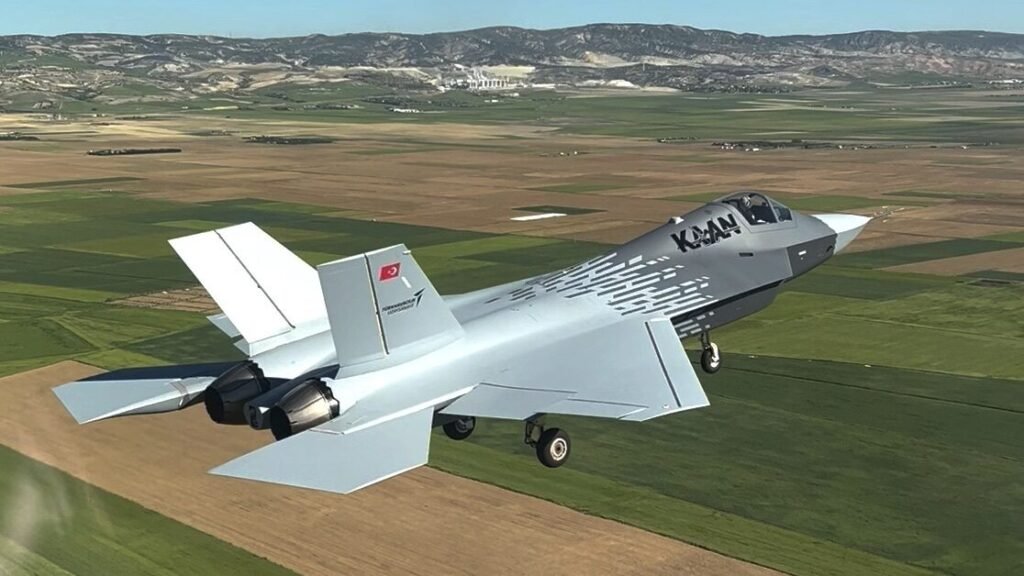The KAAN, developed by Turkish Aerospace Industries (TUSAŞ), is Turkey’s first homegrown fifth-generation fighter jet. It’s built to rival top aircraft like the F-35, with stealth capabilities, advanced sensors, and the ability to carry heavy weapons—up to 10 tons. Unveiled in 2023, it’s designed for air superiority, precision strikes, and multi-role missions. Powered by a new TF35000 turbofan engine, KAAN aims to give Turkey a strong, independent air force. Its name, meaning “ruler” in Turkish, reflects its ambition to dominate the skies. With a sleek design and cutting-edge tech, KAAN is a symbol of Turkey’s growing defense industry, catching the eye of countries like Pakistan looking for modern, affordable jets.
Why Is KAAN the Talk of the Town?
The KAAN’s buzz skyrocketed after Pakistan’s General Asim Munir met Turkey’s Defence Minister Yasar Guler in May 2025. Their talks in Istanbul focused on defense ties, with reports suggesting Pakistan’s interest in joining KAAN’s production. This meeting, attended by Turkey’s Land Forces Commander, hints at a possible deal for Pakistan to acquire or co-produce KAAN jets. Posts on X have fueled speculation, calling Pakistan a key partner for Turkey’s global ambitions with KAAN. With Pakistan’s air force needing modern jets after recent conflicts, KAAN’s low cost and high performance make it a perfect fit. This potential partnership could reshape regional power dynamics, making KAAN a hot topic worldwide.
The Asim Munir and Turkey Meeting
On May 26, 2025, General Asim Munir, Pakistan’s Army Chief, met Turkey’s Defence Minister Yasar Guler in Istanbul. Turkish media reported discussions on defense cooperation, including a joint factory for KAAN production. This meeting came after Pakistan’s military faced losses in a clash with India, pushing Munir to seek advanced jets like KAAN. The talks signal Pakistan’s aim to modernize its air force and strengthen ties with Turkey, a rising defense player. If Pakistan joins KAAN’s program, it could boost Turkey’s export goals and give Pakistan a powerful new asset.
Global Interest in KAAN
KAAN’s appeal goes beyond Pakistan. Countries like Malaysia and Egypt, which rely on older F-16 jets, see KAAN as a cost-effective alternative to the pricey F-35. Posts on X highlight KAAN’s global potential, with Turkey aiming to deliver 20 jets to its air force by 2028. Its stealth features and heavy payload make it attractive for nations seeking modern fighters without breaking the bank. The jet’s development, costing $2 billion so far, shows Turkey’s commitment to competing with global giants, drawing attention from military analysts worldwide.
Key Features of the KAAN Fighter Jet
KAAN is packed with impressive features. Its stealth design helps it evade radar, while advanced sensors provide real-time battlefield data. The jet can carry 10 tons of weapons, including long-range missiles, making it versatile for air-to-air and air-to-ground missions. The TF35000 engine, unveiled in 2025, gives it high speed and agility. KAAN also has a modern cockpit with intuitive controls and network systems for seamless communication. These features make it a formidable rival to Western jets, offering high performance at a lower cost, which is why countries like Pakistan are so interested.
Stealth and Sensor Technology
KAAN’s stealth design uses special materials to reduce its radar signature, making it hard to detect. Its advanced radar and sensors can track multiple targets at once, giving pilots a clear picture of the battlefield. These systems allow KAAN to strike with precision while staying hidden. This tech is a big draw for Pakistan, which needs jets to counter advanced air defenses after recent losses. KAAN’s sensors also support electronic warfare, jamming enemy systems, which adds to its tactical edge.
Weapon Systems and Payload
KAAN can carry up to 10 tons of weapons, from air-to-air missiles to precision-guided bombs. This heavy payload lets it handle diverse missions, from dogfights to ground strikes. Its weapon bays are built to stay stealthy, hiding munitions inside the jet. For Pakistan, this means KAAN could replace older jets like the JF-17, offering more firepower. The jet’s flexibility makes it ideal for countries looking to boost their air power without relying on Western suppliers.
Turkey’s Defense Ambitions with KAAN
Turkey wants to be a global defense leader, and KAAN is central to that goal. By building its own fifth-generation jet, Turkey reduces reliance on foreign suppliers like the U.S., which restricted F-35 sales due to political tensions. KAAN’s development, led by TUSAŞ, shows Turkey’s engineering prowess. The jet is also a key export product, with Turkey eyeing markets in Asia and the Middle East. The recent talks with Pakistan highlight KAAN’s role in expanding Turkey’s influence, as it offers affordable, high-tech jets to allies, strengthening military and economic ties.
Reducing Reliance on Western Suppliers
Turkey’s exclusion from the F-35 program pushed it to develop KAAN. This jet lets Turkey control its air force’s future without depending on Western nations, which often tie sales to political demands. By 2028, Turkey plans to deploy 20 KAAN jets, boosting its military independence. For allies like Pakistan, KAAN offers a chance to diversify away from U.S. or Chinese jets, reducing external pressure and enhancing strategic freedom.
Export Potential and Partnerships
KAAN’s lower cost compared to jets like the F-35 makes it attractive for countries with tight budgets. Turkey is pitching KAAN to nations like Pakistan, Malaysia, and Egypt, which need modern fighters. Posts on X suggest Pakistan could co-produce KAAN, sharing costs and tech. This partnership could make KAAN a global success, like the F-16, while boosting Turkey’s defense industry and creating jobs. Such deals also deepen Turkey’s strategic alliances, reshaping global defense markets.
Pakistan’s Interest in KAAN
Pakistan’s air force needs an upgrade after losing jets in a 2025 clash with India, dubbed Operation Sindoor. General Asim Munir’s meeting with Turkey’s defense minister signals a push for KAAN to replace aging aircraft like the F-16 and JF-17. KAAN’s stealth and firepower could give Pakistan an edge in regional tensions. A joint production deal would also strengthen Pakistan-Turkey ties, offering economic benefits and shared technology. With China’s J-35 also in talks, Pakistan sees KAAN as part of a broader strategy to modernize and counter India’s air power.
Modernizing Pakistan’s Air Force
Pakistan’s air force took a hit in May 2025, losing jets to India’s Operation Sindoor. KAAN’s advanced features, like stealth and heavy payloads, make it a strong candidate to replace older models. Its ability to counter advanced defenses aligns with Pakistan’s need to match India’s growing air power. By adopting KAAN, Pakistan could regain confidence in its military, especially after public criticism of its recent losses, as noted in news reports.
Strategic Alliance with Turkey
The Munir-Guler meeting underscores a growing Pakistan-Turkey alliance. A joint KAAN factory, as mentioned in Turkish media, could deepen this partnership. For Pakistan, co-producing KAAN means access to cutting-edge tech and economic gains. For Turkey, it’s a chance to cement Pakistan as a key ally, boosting KAAN’s global reach. This collaboration could shift regional dynamics, giving both nations a stronger stance against rivals.
Challenges Facing KAAN’s Development
KAAN’s journey isn’t without hurdles. Developing a fifth-generation jet is costly—$2 billion so far—and Turkey faces economic challenges. The TF35000 engine, while promising, is still in testing, with prototypes expected by 2026. Delays could push back the 2028 delivery goal. Export deals, like with Pakistan, depend on proving KAAN’s reliability against rivals like the F-35 or J-35. Geopolitical tensions, especially with the U.S., could also limit Turkey’s access to tech or markets. Still, KAAN’s progress shows Turkey’s determination to overcome these challenges.
Technical and Financial Hurdles
Building KAAN costs billions, and Turkey’s economy is under strain. The TF35000 engine’s development is complex, needing years of testing to match Western standards. Any delays could raise costs or scare off buyers like Pakistan. TUSAŞ must balance quality and affordability to compete with pricier jets like the F-35. Despite these challenges, Turkey’s investment in KAAN reflects its long-term vision for a self-reliant defense industry.
Geopolitical Risks
Turkey’s push for KAAN has stirred tensions with the U.S., which sees it as a rival to the F-35. Sanctions or export restrictions could limit KAAN’s global reach. Pakistan’s interest also risks escalating regional rivalries, especially with India, which views Turkey-Pakistan ties warily. Balancing these geopolitical pressures while expanding KAAN’s market will test Turkey’s diplomatic skills, especially after high-profile talks like the Munir-Guler meeting.
The Future of KAAN and Global Impact
KAAN’s future looks bright but challenging. By 2028, Turkey aims to field 20 jets, with more to follow. Success in exports, especially to Pakistan, could make KAAN a global hit, like the F-16. Posts on X highlight excitement about KAAN’s role in making Pakistan a defense hub alongside Turkey and China. If KAAN proves reliable, it could shift air power dynamics, giving smaller nations access to advanced jets. The Munir-Guler talks have put KAAN in the spotlight, signaling a new era for Turkey’s defense ambitions and its alliances.
Final Thoughts on the KAAN Fighter Jet
The KAAN fighter jet is more than a plane—it’s a symbol of Turkey’s drive to lead in global defense. Its stealth, firepower, and affordability make it a game-changer, especially for allies like Pakistan, eager to modernize after recent setbacks. The buzz from General Asim Munir’s meeting with Turkey’s defense minister shows KAAN’s potential to reshape alliances and air power. Despite challenges like costs and geopolitics, KAAN’s progress is impressive. Keep an eye on this jet—it’s set to soar and shake up the skies for years to come.



